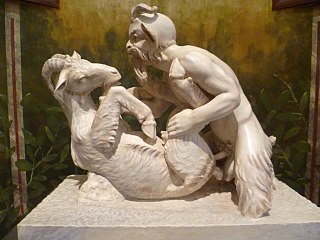
Erotic art in Pompeii and Herculaneum has been both exhibited as art and censored as pornography. The Roman cities around the bay of Naples were destroyed by the eruption of Mount Vesuvius in 79 AD, thereby preserving their buildings and artefacts until extensive archaeological excavations began in the 18th century. These digs revealed the cities to be rich in erotic artefacts such as statues, frescoes, and household items decorated with sexual themes. The ubiquity of such imagery and items indicates that the treatment of sexuality in ancient Rome was more relaxed than in current Western culture. However, much of what might strike modern viewers as erotic imagery, such as oversized phalluses, could arguably be fertility imagery. Depictions of the phallus, for example, could be used in gardens to encourage the production of fertile plants. This clash of cultures led to many erotic artefacts from Pompeii being locked away from the public for nearly 200 years.

Lucius Caecilius Iucundus was a banker who lived in the Roman town of Pompeii around 14–62 CE. His house still stands and can be seen in the ruins of the city of Pompeii which remain after being partially destroyed by the eruption of Vesuvius in 79 CE. The house is known both for its frescoes and for the trove of wax tablets discovered there in 1875, which gave scholars access to the records of Iucundus' banking operations.

The Last Days of Pompeii is a novel written by Edward Bulwer-Lytton in 1834. The novel was inspired by the painting The Last Day of Pompeii by the Russian painter Karl Briullov, which Bulwer-Lytton had seen in Milan. It culminates in the cataclysmic destruction of the city of Pompeii by the eruption of Mount Vesuvius in AD 79.

The Villa Poppaea is an ancient luxurious Roman seaside villa located in Torre Annunziata between Naples and Sorrento, in Southern Italy. It is also called the Villa Oplontis or Oplontis Villa A. as it was situated in the ancient Roman town of Oplontis.

The Villa of the Mysteries is a well-preserved suburban ancient Roman villa on the outskirts of Pompeii, southern Italy. It is famous for the series of exquisite frescos in Room 5, which are usually interpreted as showing the initiation of a bride into a Greco-Roman mystery cult. These are now among the best known of the relatively rare survivals of Ancient Roman painting from the 1st century BC.

The Pompeian Styles are four periods which are distinguished in ancient Roman mural painting. They were originally delineated and described by the German archaeologist August Mau (1840–1909) from the excavation of wall paintings at Pompeii, which is one of the largest groups of surviving Roman frescoes.

Pompeii and Herculaneum were once thriving towns, 2,000 years ago, in the Bay of Naples. Both cities have rich histories influenced by Greeks, Oscans, Etruscans, Samnites and finally the Romans. They are most renowned for their destruction: both were buried in the AD 79 eruption of Mount Vesuvius. For over 1,500 years, these cities were left in remarkable states of preservation underneath volcanic ash, mud and rubble. The eruption obliterated the towns but in doing so, was the cause of their longevity and survival over the centuries.
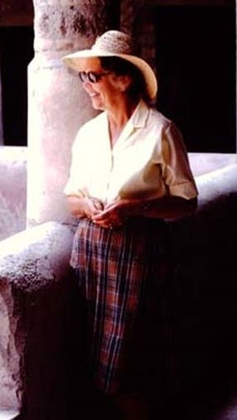
Wilhelmina Mary Feemster Jashemski was an American scholar of the ancient site of Pompeii, where her archaeological investigations focused on the evidence of gardens and horticulture in the ancient city. She is remembered for her contributions to archaeobotany at Pompeiian sites, as she developed methods for preserving the remains of roots from antiquity, known as root casting.
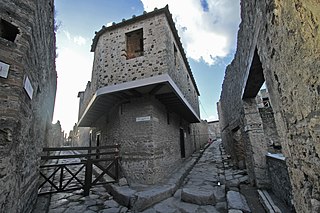
The Lupanar of Pompeii is the ruins of a brothel in the Ancient Roman city of Pompeii. It is of particular interest for the erotic paintings on its walls. Lupanar is Latin for "brothel". The Pompeii lupanar is also known as Lupanare Grande or the "Purpose-Built Brothel". After becoming a Roman Colony, Pompeii was closely associated with Venus a deity of sex and a mythological figure closely tied to prostitution.

The House of the Tragic Poet is a Roman house in Pompeii, Italy dating to the 2nd century BCE. The house is famous for its elaborate mosaic floors and frescoes depicting scenes from Greek mythology.
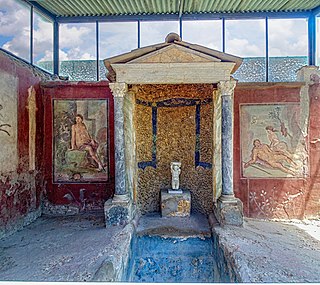
The House of Loreius Tiburtinus is renowned for well-preserved art, mainly in wall-paintings as well as its large gardens.

Villa Boscoreale is a name given to any of several Roman villas discovered in the district of Boscoreale, Italy. They were all buried and preserved by the eruption of Mount Vesuvius in 79 AD, along with Pompeii and Herculaneum. The only one visible in situ today is the Villa Regina, the others being reburied soon after their discovery. Although these villas can be classified as "rustic" rather than of otium due to their agricultural sections and sometimes lack of the most luxurious amenities, they were often embellished with extremely luxurious decorations such as frescoes, testifying to the wealth of the owners. Among the most important finds are the exquisite frescoes from the Villa of Publius Fannius Synistor and the sumptuous Boscoreale Treasure of the Villa della Pisanella, which is now displayed in several major museums.
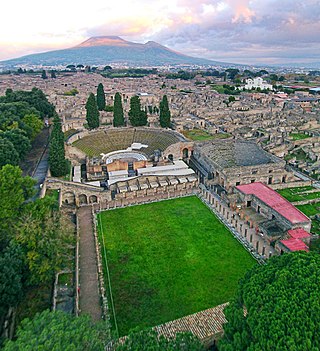
Pompeii was an ancient city located in what is now the comune of Pompei near Naples in the Campania region of Italy. Pompeii, along with Herculaneum and many villas in the surrounding area, was buried under 4 to 6 m of volcanic ash and pumice in the Eruption of Mount Vesuvius in 79 AD.

Stabiae was an ancient city situated near the modern town of Castellammare di Stabia and approximately 4.5 km southwest of Pompeii. Like Pompeii, and being only 16 km (9.9 mi) from Mount Vesuvius, this seaside resort was largely buried by tephra ash in 79 AD eruption of Mount Vesuvius, in this case at a shallower depth of up to 5 m.

The House of the Centenary was the house of a wealthy resident of Pompeii, preserved by the eruption of Mount Vesuvius in 79 AD. The house was discovered in 1879, and was given its modern name to mark the 18th centenary of the disaster. Built in the mid-2nd century BC, it is among the largest houses in the city, with private baths, a nymphaeum, a fish pond (piscina), and two atria. The Centenary underwent a remodeling around 15 AD, at which time the bath complex and swimming pool were added. In the last years before the eruption, several rooms had been extensively redecorated with a number of paintings.

Wilhelm Johann Karl Zahn was a German architect, painter, art critic and design researcher particularly of Roman interior designs found in the ruins of Pompeii. Wilhelm was born as the fourth of five children of painter Bernhard Zahn, and his wife, Christiane, née Weis according to church records. He attended high schools in Bückeburg and Rinteln where he received a universal education. It was in Rinteln where Zahn studied the classics under a Professor Stein who Zahn remembered with particular affection.
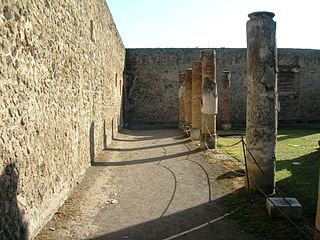
Caius Norbanus Sorex was an actor who lived in Italy and was active at Pompeii and Nemi during the time of Augustus.
The conservation and restoration of Pompeian frescoes describes the activities, methods, and techniques that have historically been and are currently being used to care for the preserved remains of the frescoes from the archeological site of Pompeii, Italy. The ancient city of Pompeii is famously known for its demise in A.D. 79 after the fatal eruption of Mount Vesuvius wiped out the population and buried the city beneath layers of compact lava material. In 1738, King Charles III or Charles of Bourbon, began explorations in Portici, Resina, Castellammare di Stabia, a Civita, where it was believed that the ancient cities of Pompeii, Stabiae, and Herculaneum were buried beneath. The first phase of the excavations at Pompeii started in 1748, which led to the first conservation and restoration efforts of the frescoes since their burial, and in 1764, open-air excavations began at Pompeii. Pompeii has a long history of excavation and restoration that began without a strong foundation or strategy. After centuries of cronyism, recurring financial shortages, and on-again-off-again restoration, the city's frescoes and structures were left in poor condition. In 1997, Pompeii was added to the UNESCO List of World Heritage Sites.
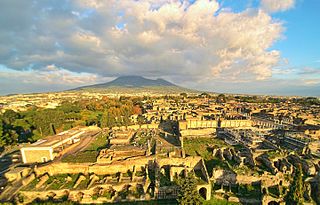
Several non-native societies had an influence on Ancient Pompeian culture. Historians’ interpretation of artefacts, preserved by the Eruption of Mount Vesuvius in 79, identify that such foreign influences came largely from Greek and Hellenistic cultures of the Eastern Mediterranean, including Egypt. Greek influences were transmitted to Pompeii via the Greek colonies in Magna Graecia, which were formed in the 8th century BC. Hellenistic influences originated from Roman commerce, and later conquest of Egypt from the 2nd century BC.

Luigi Bazzani, also called Il Bazzanetto, was an Italian painter, illustrator, and watercolorist. He was born November 8, 1836, in Bologna, Italy. Bazzani studied at Bologna's Accademia di Belle Arti then traveled to France, Germany and, eventually, Rome where he settled down in 1861 and began to specialize in genre and landscape subjects as well as set designs for theaters. Many of his paintings featured the remains of the city's monuments from classical antiquity.


























